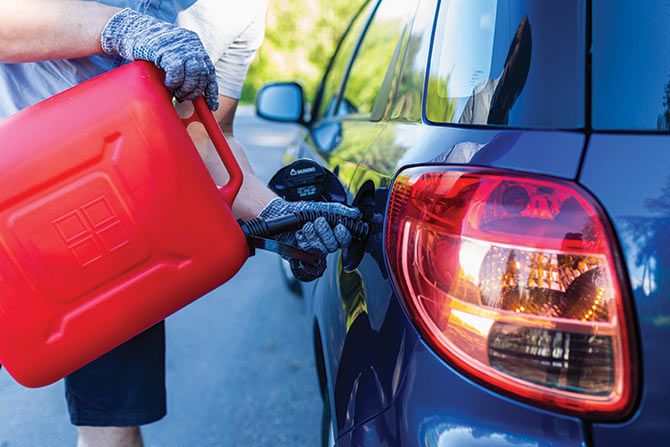What Happened
In the parking lot of a dealership in southern California, an individual was rinsing cars with DI water using pressure washer equipment located on the back of a pickup truck. The pressure washer had a gasoline-powered motor. During the course of rinsing, the gasoline level went low. The operator got a can full of gasoline and started pouring gasoline into the gasoline tank on the pressure washer while the motor was running. A fireball and explosion resulted. The gasoline spilled on the plastic bed of the pickup truck, and the flames quickly melted the plastic. Surprisingly, the operator suffered minimal injuries, and there were no damages beyond the pressure washer equipment and bed of the pickup truck. The General Manager noted that years of safety training and preparedness paid off. Employees trained by CSI responded quickly with fire extinguishers and put out the fire. The fire could have seriously harmed the operator and expanded beyond the truck. Safety training in both handling and storage of flammable materials and emergency response is paramount to avoid such types of accidents.
Gas Can
The maintenance and operation of gasoline tanks, both aboveground and underground, has become expensive, highly regulated, and burdensome. Automobile dealers have resorted to gas dolly equipment where a small amount of gasoline can be added to each new automobile delivered to the dealership. We note that automobiles delivered to dealerships from manufacturers have very small amounts of gasoline; this being a result of U.S. Department of Transportation (DOT) regulations, which dictate that minimal amounts of gasoline be retained in gas tanks of vehicles in transport. This memo briefly discusses the DOT, OSHA, and CARB regulations applicable to the gas can used to transport from a public gasoline station to dealerships to later fill in automobiles on the lot.
Federal DOT Regulations
Gasoline transport is discussed in Section 173.6 of the DOT regulations under “material of transport exceptions.” The least burdensome regulations require that a container being used to transport gasoline must be less than eight gallons per container and a maximum of 72 total gallons (440 pounds) on the vehicle. At this level, only a regular driver’s license is needed, and no placarding is required for the vehicle. Driver training must include Hazard Communication Program (29 CFR 1910.1200) and DOT Materials of Trade training. Transport of gasoline in the amount greater than listed above increases the regulatory burden. (https://www.nwcg.gov/sites/default/files/publications/pms442.pdf and http://www.gpo.gov/fdsys/pkg/CFR-2011-title49-vol2/pdf/CFR-2011-title49-vol2-sec173-6.pdf)
Safety
Safety concerns for gasoline containers are as follows:
- Properly labeled container with hazard warnings. Wear eye protection and nitrile gloves.
- The containers must be secured in the vehicle.
- Containers UL certified.
- Containers must be closed to minimize the risk of spills and creating a fire hazard.
- Spill-proof spouts also lock in vapors to avoid vapor release while in storage. Do not overfill gas tanks on automobiles.
- Store on a flat surface and transfer in areas with good ventilation or open areas.
- 29 CFR § 1926.152(a)(1) states that “Only approved containers and portable tanks shall be used for storage and handling of flammable liquids. Approved safety cans or DOT-approved containers shall be used for the handling and use of flammable liquids in quantities of five gallons or less.”
- Bonding of containers to eliminate static electricity both at the time of filling up the containers and when transferring from container to container should be undertaken. Keep containers on the ground when filling and not on the bed of the truck. Use grounding wire when necessary. Keep nozzle in contact with can during filling. Do not fill containers over 95% to allow for expansion. Spilled gasoline must evaporate before containers are put on the truck.
- Transport vehicle must have a spill kit available to contain an accidental spill. Operator must be trained on containing, cleaning, and managing an accidental spill.
- Ignition sources such as open flames, torches, running motors, electrical tools & equipment, etc. must be at least 20 feet (measured horizontally) from the flammable material, per 29 CFR § 1926.352(c).
- One 5-B:C or two 4-B:C fire extinguishers are mandatory on the vehicle transporting gas.
Plastic or Metal
Studies at Worcester Polytechnic Institute’s Department of Fire Protection Engineering, as reported by NBC News in late 2013, have indicated that under certain conditions, plastic cans are vulnerable to fires with explosive force. The conditions that present the higher risk include having a very small amount of gasoline (a few teaspoons) inside the gas can, cool temperatures, tilting the can at 42 degrees (typical pour angle) and, of course, a spark! The employees should be trained to avoid these risky conditions and even buy metal cans in the future. (https://www.nbcnews.com/news/world/watch-gas-can-explode-lab-test-flna2d11691287)
CA Air Resources Board (CARB)
As of July 1, 2007, all Portable Fuel Containers (PFC) sold in California must be certified by the Air Resources Board as meeting low-emission standards and regulatory requirements. This regulation is applicable to manufacturers and retailers who place gas cans in the stream of commerce. Only containers of ten gallons or less are covered by this regulation, so the sale of a 25-gallon gas caddy for shop use is exempt from CARB regulations. The following table provides a listing of those CARB-approved containers certified for sale: http://www.arb.ca.gov/consprod/fuel-containers/pfc/eo/eo.htm.
Summary
CA-based businesses have only CARB-approved containers available. Other states may use these CARB-approved containers with vapor locks that are spill-proof and emit negligible flammable vapors and hence, are safer. Training in hazardous materials, including information on risks associated with plastic cans, should be provided to employees. Following safety and operation instructions on the PFC is also mandatory.
DISCLAIMER: The contents of this article are for informational purposes only and are not to be considered as legal advice. Employers must consult their lawyer for legal matters and EPA/OSHA consultants for matters related to Environmental, Health & Safety. The article was authored by Sam Celly of Celly Services, Inc., who has been helping automobile dealers in Arizona, California, Hawaii, Idaho, Nevada, New Mexico, New York, Texas, and Virginia comply with EPA and OSHA regulations for over 35 years. Sam is a Certified Safety Professional (No. 16515) certified by the National Board of Certified Safety Professionals. Sam received his BE (1984) and MS (1986) in Chemical Engineering, followed by a J.D. from Southwestern University School of Law (1997). Sam is a member of the American Chemical Society (No. 31176063), American Industrial Hygiene Association (No. 124715), and National Association of Dealer Counsel (NADC). Sam also serves on the Board of Orange County American Industrial Hygiene Association and on CA Industrial Hygiene Council (CIHC). Our newsletters can be accessed at www.epaoshablog.com. Your comments/questions are always welcome. Please send them to sam@cellyservices.com.






